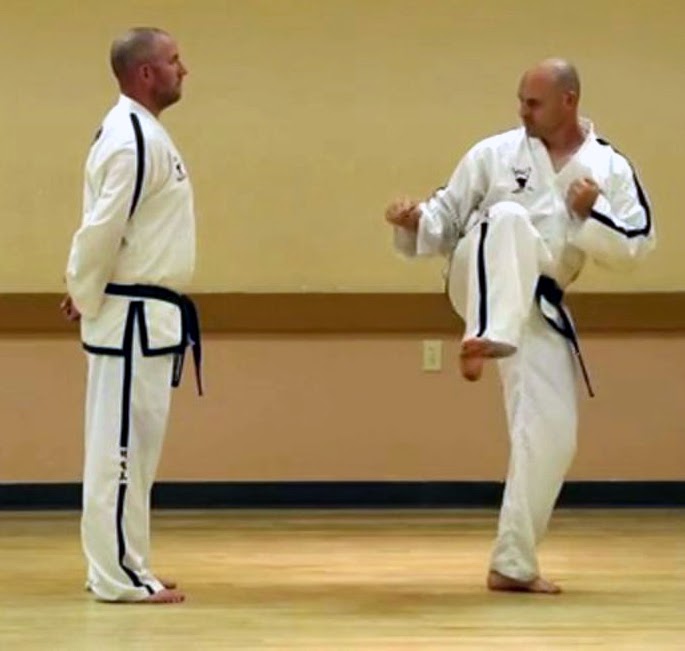Mui Thai boxers tend not to chamber, and they get a ton of power in them.
I'm watching it at 0.25 speed. They are chambering. Especially the higher kicks. There is a half-chamber in the lower kicks. So if anything, it's for kicking lower. But there's still a chamber and the quads are engaged in the kick.
This was specifically taught for roundhouse, just to clarify, other kicks would be chambered. And you've likely not been taught it as we practice different styles.
It appears to me there is a chamber, it's just shorter and lower. And the benefit of that chamber is it's faster on lower kicks.
---
@CB Jones @Jaeimseu @Buka
My experience is that any kick can be made fast or powerful by training, but you also have to compare it to the other kicks. My front kick is going to be stronger than the side kick of our white belts. That doesn't mean the front kick is strong compared to side kick. If I train the front kick and ignore the side kick, it will be my stronger kick. But if I train both, then my side kick will always be stronger, front kick always faster.
Now, as to rear leg vs. front-leg. Front leg is like a jab (in more ways than one). It's faster, but weaker, than a rear leg kick (this is another concept I wanted to cover). Different kicks are affected in different ways. The side kick loses some power, but gains a LOT of speed, because you're already angled right for it. The roundhouse kick gains some speed, but loses a lot of power because you've lost the turning in your body. Front kicks are probably going to be done in more of a cat stance and will be a bit more defensive.
The front-leg side kick is often a brake check for your opponent, a way to block their distance-closing moves (and is an example of a kick you would do with a slighter chamber). While it can be powerful, I feel a back kick doesn't sacrifice much in terms of speed and can deliver more power than a front-leg side kick.
Question: would a step-behind side-kick be considered a front-leg or rear-leg side kick?
The safest kick is the foot sweep. Even if you don't sweep your opponent down, it can interrupt your opponent's forward attack.
The next safest kick is front kick to the knee joint. If your opponent tries to catch it, both of your hands can hit on his face.
A lot of arts treat kicks as lower-body attacks only, or lower-body attacks primarily. I get why they do that.
Although if the foot sweep is part of a throw, I don't personally consider it a kick. I consider it a grappling technique, and kicks are striking techniques. But that's because most of the sweeps we do at my school are involved in steps and stance changes, so it feels more like footwork than kicking to me.
Regarding wrestling - maybe initiating with a kick is a bad idea, but if he shoots for a leg takedown I imagine a knee to the face would be quite the crimp in his plans. A wrestler also has 2 arms vs. a striker's 4 legs. So if you kick low and he goes down for your leg, as you said - punch his face.
The side kick has the following weakness:
- You will have one long leading arm and one short back arm at that moment. If your opponent uses your leading arm to jam your back arm, you will be in trouble.
- It's easier for your opponent to catch at your ankle.
The roundhouse kick is easy to be caught.
The front kick doesn't have these issues.
IMO, front kick > side kick > roundhouse kick.
I can catch all 3 kicks easy. Roundhouse kick - move in close and grab the thigh. Front kick - move off to either side and grab under the knee. Side kick - depends whether you go inside or outside of it. With the roundhouse kick and side kick you're at least at an angle and have better balance. With the front kick it's easier to fold you over backwards on your knee.
When you execute the side kick, you're actually pointing away from the opponent. It would be very hard for your opponent to jam your arms. It would be easier in the other kicks. And, since your body is turned, you can easily turn the other way and attack with a spinning elbow, spinning chop, or spinning backfist. Or use your other hand to trap theirs and spin to lock their wrist or elbow and take them down.
Each kick has its pros and cons. Front kicks are fast and do a good job of hitting soft targets or snapping the head back. Roundhouse kicks just accumulate pain over time. Side kicks (and front kicks) can be used as crowd control to push people or block people, or can be used for devastating blows to the stomach or face. Roundhouse kicks also set up spinning kicks quite well. Which one I use depends on my situation, distance, intended target, intended result, the capabilities of my opponent, and the rules (or lack thereof) that I am fighting under.


